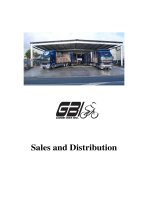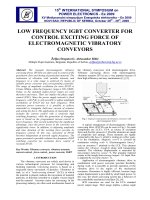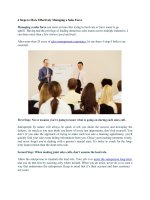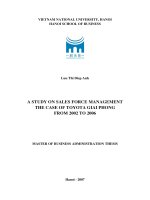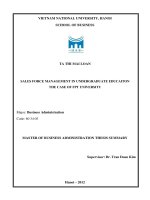sales force managment
Bạn đang xem bản rút gọn của tài liệu. Xem và tải ngay bản đầy đủ của tài liệu tại đây (120.14 KB, 28 trang )
Motivation
1
Discussion Questions
What is the best way to motivate a
salesforce?
How can you systematically design a
motivation system?
2
Three Major Determinants of
Motivation
Environmental conditions
The firm’s management policies
compensation
supervision
task characteristics
Personal characteristics of the
salesperson
3
Motivation Session
Objectives
understand the components of motivation
through the expectancy-value model
relate management tools to components
of the expectancy-value model, to use in
influencing motivational levels
consider how management style and the
use of various “tools” influence motivation
4
Motivation Session Outline
Locus of Control and Motivation
Expectancy-Value Model of motivation
what is it?
Who cares? (implications of the model)
Glengarry Glen Ross & the impact of
the sales manager on motivation
The impact of role stress
5
Locus of Control and
Motivation
Locus:
External vs. internal attributions
Stable vs. unstable attributions
Examples:
External Stable:
External Unstable:
Internal Stable:
Internal Unstable:
6
The Expectancy-Value model
Why are people motivated
to initiate a task
to choose a certain effort level
to persist in a task
Expectancy Principle: salespeople choose a level
of effort based on the expected payoffs of
alternative effort levels
Most popular model of motivation (at least
among sales force researchers)
7
Expectancy-Value Model in
Notation
Mj=Ej x Vj where:
Mj=motivational drive to achieve level j of
performance (e.g. sales, number of new accounts
etc.)
Ej =beliefs about the effort to performance linkage:
perceived chances of achieving level j of
performance given effort
Vj = overall subjective utility (valence or value) of
achieving level j of performance
8
Examples:
Ej
Vj
Mj
Level of Performance
80% 60
48
If j=$200,000 in sales
40% 100
40
If j=$300,000 in sales
10% 80
8
If j=$400,000 in sales
9
Valence/Value: Vj
Valence is a composite of the utility you derive
from the suboutcomes (consequences) that
accompany achieving level j of performance
These might include:
more pay, promotion, liking & respect, lack of leisure
time, personal growth
security, sense of accomplishment, recognition, hurting
personal life
Outcomes can have negative utility/valence
Obviously the list could be longer & vary across
individuals
10
Vj= (Iij x Vi)
Vj = expected overall utility to an individual of achieving
performance level j
Iij = beliefs about the performance to suboutcomes linkages: the
individuals subjective probability that achieving performance
level j would create suboutcome I (instrumentalities)
Example: 30% chance that selling $300K (performance level j)
would get one a promotion (suboutcome I)
Vi = the utility an individual derives from suboutcome I
(e.g., a promotion) Note: this can be negative
11
That’s nice, but who cares?
Nobody thinks like this (it’s too
complicated)
But model holds up well in field
testing (good “as if” model)
Explains up to 40% of variance in
performance
12
Expectancy-Value Model
Advantages
Model is a handy way to structure a messy
question
Forces you to project o each individual’s
underlying beliefs (expectancies) and
needs/wants (values)
Different people can exhibit the same level
of motivation for very different reasons
Nice vocabulary to talk about motivation
13
Implications for How to
Motivate
No reward is motivating if it is out of reach (low expectancy)
Raising the goal (performance level j) often depresses
motivation
Introduces negative outcomes
Depresses expectancies
Can motivate by trying to induce sales people to:
raise expectancy (I.e. through training, encouragement)
consider a negative suboutcome unlikely
consider a positive suboutcome likely
Add a new positive suboutcome
Change their ideas about whether suboutcomes are desirable or
undesirable (vi: doomed strategy for the most part)
14
Glengarry Glen Ross
what is the impact of management style on the
components of the expectancy value model?
What motivational “tools” are used?
How do these tools impact motivation in the
short-term? Over the long term?
How do these tools impact extrinsic motivations?
Intrinsic motivation?
15
Motivators
Positive Motivators
Commission
Recognition
Acceptance
Respect
Trust
Achievement
Pride
Negative
Motivators
Fear
Intimidation
Revenge
Obligation
Social Comparison
(one-up)
16
Sales Manager Objectives &
Tools
Objectives:
Increase magnitude and accuracy of expectancies
Increase accuracy of instrumentalities
Understand and work with valences
Key:
reduce role stress arising from role ambiguity & role conflict
Tools:
training: expectancies
evaluations, reviews: expectancies, instrumentalities
communication, participation: instrumentalities
selection: hire SP whose Vi’s match company suboutcomes
17
How to Motivate
Define each employee’s motivating factors and
provide an environment that incorporates those
factors
Praise performance
Address poor performance
Set goals & clearly communicate expectations
Share your vision and include your team in creating it
18
Measuring Components of the Model
May be done informally for small sales forces, but
beware of biases (e.g. we believe what we want to
believe; we think everyone else is like we are)
periodic surveys can be conducted to quantify each
component of the model
expectancies: to what extent do you believe that if you do x,
y will happen
instrumentalities: to what extent do you believe that if y
happens, you’ll receive z
valences for suboutcomes: how important is ..
Quantified information is valuable at both the
aggregate level and the individual level
19
Role Stress
“A primary influence on how salespeople perform is their
perceptions of the demands placed upon them”
“A role is a prescription:
it tells you the activities and behavior that are expected of anyone
in a position
Role partners
communicate expectations
pressure salespeople to meet them
A role partner is anyone with a vested interest in how a
salesperson does the job, such as:
the boss, the customers, other executives, other salespeople and
support people, people who are significant in the sales rep’s
personal life
20
Role Stress (continued)
Role stress is like a disease; most reps suffer
complications of role stress
Why?
Sales is at the boundary of the firm; salespeople are boundary
spanners, which means lots of role partners
Salespeople often have to be creative; find solutions; reconcile
needs
A sales reps performance affects performance of lots of other
people
Sales reps personify the cruel voice of the marketplace
(scapegoat- kill the messenger)
Time and resource constraints necessitate tradeoffs between
role partners’ expectations
21
Role Stress (continued)
Day after day, salespeople grapple with the
messages their role partners send them and the
pressures role partners put on them.
Two things create role stress (create problems
that eventually will make the salesperson
miserable):
Perceived Role Conflict
Perceived Role Ambiguity
22
Perceived Role Conflict:
you feel that the demands of your role partners
are incompatible. To make one happy, you have
to upset another (perceived).
Upshot: misery & poor motivation
23
Perceived Role Ambiguity:
You feel you don’t have the information to cope
with your job demands
don’t
don’t
don’t
don’t
SUM:
know how to do a task
know what role partners expect
know how your performance is being evaluated
have clear objectives
unsure how you’re doing and what to do next
24
How to reduce Role Stress
Communicate! Give feedback!
Even bad news is better than news
Salespeople must have accurate expectancies &
instrumentalities
Training and encouragement: increase expectancies
for desired levels of performance- people who believe
they can, often do
Accept that some role stress is normal (even
desirable)
but be especially alert for dysfunctional levels of role
stress in inexperienced people
25

